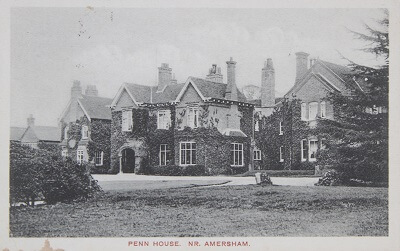The unique heritage asset on Chesham Bois Common by Alison Bailey.
The Old Rectory in Chesham Bois is an attractive, richly detailed and rather grand, brick building in the style of a small Tudor manor house. In the heart of the Conservation Area, it tells a story of the village’s rural past long before the arrival of the railway and the development of Amersham-on-the-Hill. It is a unique house in the village as it is the only residence on common land on the south side of North Road. It is also the only property in the village built in the ‘Russell’ style by the Duke of Bedford when he was Lord of the Manor of Chesham Bois. The ducal coronet is displayed on the gable above the entrance porch and the distinctive individual-cut brick chimneys echo the Tudor chimneys of Chenies Manor, four miles away, also part of the Duke’s vast estate.

The house was built as a rectory in 1833 to replace an earlier, much humbler parsonage. The foundations of the earlier parsonage are now part of the garden but the early 18th century stable block still survives. Like the Old Rectory, it is Grade II Listed.
The population of Chesham Bois in the 1830s (just 157 in the 1831 Census) certainly did not merit such a grand building but the Duke had appointed a new incumbent in 1830 and had obviously decided that the existing parsonage was no longer adequate. He wanted the house to reflect the status of the new rector as he had just appointed a relative, the recently ordained, 25-year-old, Hon. Lowther Barrington. He was the youngest son of the Duke’s cousin, Elizabeth Adair and Viscount Barrington of Ardglass.
The Duke had not shown much interest in Chesham Bois before and had started to sell off his farmland here in the late 18th century. The manor house had fallen into disrepair and had been mostly demolished with only a corner of it surviving inside the structure of the newly built Chesham Bois House. As the village had such a small population it is difficult to see what attracted Lowther Barrington to Chesham Bois. There were just a few houses around the church and a handful of cottages scattered around farms. Perhaps the Duke offered him a decent living (he had five older siblings) or he was attracted by the excellent reputation of the clerical school established by a previous incumbent, Thomas Clarke. Barrington was ambitious, he later held the office of the Canon of St Albans, so perhaps the attraction for him was that he would be the leader of the community here. The Lord of the Manor, the Duke, lived 35 miles away in Woburn Abbey and had little involvement in the parish.

In October 1837, Barrington married Lady Catherine Georgiana Pelham, the daughter of the 2nd Earl of Chichester. They spent their honeymoon at nearby Penn House, the seat of Earl Howe before starting married life at the Rectory in Chesham Bois. Their first child, Alice Emily was born here but just one year later the family had moved to the rectory at Watton, Hertfordshire. This was a larger parish more suited to an ambitious cleric.
It would be another 50 years before Chesham Bois started to expand following the arrival of the railway. St Leonard’s Church, which had fallen into disrepair, was renovated and extended in 1911 and 10 years later, Reverend Fitzpatrick and his wife paid for a community hall to be built in the rectory grounds. There was also a grass court tennis court in the grounds used by the village which is where the Chesham Bois Lawn Tennis & Squash Club was first founded. A fundraising campaign raised enough money to build the existing Parish Hall in 1937 and after some controversy, the current Parish Centre was developed in the early 1980s. The grass tennis court was lost when the hall was extended, offices built, and additional car parking added. After the new rectory was completed, the Old Rectory was sold at auction at The Crown Hotel in 1983 and is now a private house.
In 2020, a planning application was submitted to the Council for a major commercial and residential development on glebe land adjacent to the Chesham Bois Common and within the Conservation Area, which has proved to be highly controversial. The proposed development includes a range of different buildings which would accommodate around 400 people, and the associated car parking requirements would result in the historic Glebe Field being turned into a car park. This would be the largest development in Chesham Bois for over 100 years and it needs careful consideration because of the sensitivity of the site. The proposed development site is adjacent to the listed Old Rectory and stables, and surrounded by another seven listed buildings, including Anne’s Corner and the War Memorial. These greenfield areas and listed properties are all features of special architectural and historic interest and the Chesham Bois Conservation Area was established in law in 1992 to protect this lovely part of the village for future generations to enjoy. Buckinghamshire County Council declined application PL/20/0401/FA 15 January 2021.

